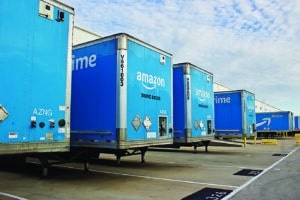
The latest proposal for Boston’s industrial Widett Circle would see a large Amazon distribution center built to compliment its existing Revere facility.
When it comes to neighborhood–building, it’s time for Boston to go big or go home.
And yes, I’m talking about Widett Circle, that long-time food warehouse site by the Southeast Expressway eyed for a stadium six years ago during Boston’s ill-fated bid to host the Olympics.
Now, Widett Circle is back in the headlines amid news Amazon is eyeing the site for a massive distribution center.
The backlash has been swift.
With a big “Amazon Bad For Boston” message on its electronic message board overlooking the Southeast Expressway, construction union IBEW Local 103, has made it clear where it stands on the future of the 25-acre site.
For its part, The Boston Globe, which first broke the news, ran a front-page column last week by its star business columnist all but calling upon City Hall to intervene so Widett Circle can be transformed into the city’s next great neighborhood.
“If we can put a breakthrough vaccine in arms, we can put a great neighborhood in Widett,” the Globe’s Shirley Leung wrote.
It’s a wonderful sentiment, but exactly what kind of neighborhood are we talking about here?
For if we are looking at Seaport II, Boston’s next mayor would be better off taking a pass.
No Lipstick for This Pig
The Seaport’s problems go well beyond its generic, cookie–cutter design of glass and steel high-rises.
No amount of additional green space or public amenities can put lipstick on this pig and change the fact the Seaport is a prime example of our nation’s growing economic inequality, a gap between the have-it-alls and everyone else that is driving ever more dangerous levels of political turbulence and rage.
If the Seaport is a neighborhood, then its residents are primarily the big corporations that rent or own office space there, as well as the uber–wealthy condominium owners who can afford to plunk down millions for a perch in a waterfront tower.
How many of these units are actually, truly lived in – as opposed to be being held by real estate speculators – is anyone’s guess.
We are not just talking economic equality here, but also racial equality, with the new neighborhood – and frankly we should use that term loosely – being almost entirely white.
Maybe even more depressing, this all happened despite an infusion of more than $1.8 billion into the new federal courthouse, the new convention center, the extension of the Silver Line, and tax breaks for developers, according to figures in a 2017 Globe Spotlight story.
And that’s not including the $12 billion spent as part of the Big Dig on boring a tunnel underneath the neighborhood, which also connects it directly to 1nterstate 90 and the larger highway network.
A Great Opportunity – For Homes
Turning Widett Circle a true Boston neighborhood, one with a substantial amount of housing for middle- and working-class families, will also require city and state officials to pony up a substantial amount of money as well.
But unlike the Seaport, Boston should consider taking control of the site, either by purchasing it directly, or if necessary, by eminent domain.
Yes, it would cost a lot of money – at least $175 million, if not more – but it would remove the astronomical site acquisition costs developers cite when building luxury housing.
And it would also let city planners and the public, not rival groups of developers, set the agenda.
After all, Boston took over dozens of acres in the Seaport back in in the 1990s to make way for a new convention center, a project, that, whatever its merits, the city needed less at the time than it needs affordably priced housing today.
City Has Leverage Over Amazon
But if Boston can’t do it right this time – or doesn’t truly want to try – then it’s time for Plan B.
That means making Widett Circle a hub for well–paying, blue-collar jobs, something as scare now as a reasonably priced home.
For city officials in Boston, that means drawing a line in the sand and telling Amazon – or, for that matter, anyone else trying to build a distribution or warehousing center – they will have to play ball, paying both a living wage and benefits and agreeing to decent working conditions.
Companies are constantly playing off cities and states against each other, squeezing out tax breaks and other goodies by threatening to build elsewhere, whether the next state over or overseas.
But when it comes to Amazon and Widett Circle, here’s a case where city officials have the leverage, and not the other way around.

Scott Van Voorhis
Amazon’s business model depends on being able to set up distribution centers near its customers in the city, and Boston is a prime market for the online retail giant.
Amazon doesn’t just want to be here – Amazon needs to be here.
One way or another, Widett Circle represents a big chance to improve life for Boston’s hard-pressed and steadily shrinking number of middle– and working-class families that still call the city home.
Here’s hoping Boston’s next mayor, whoever it winds up being, doesn’t blow it.
Scott Van Voorhis is Banker & Tradesman’s columnist; opinions expressed are his own. He may be reached at sbvanvoorhis@hotmail.com.




 |
| 
